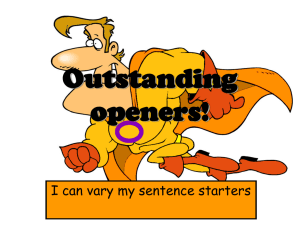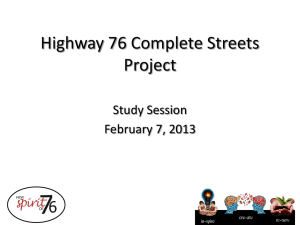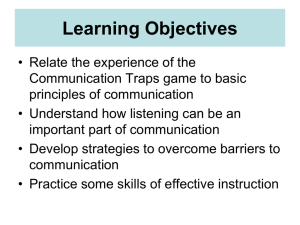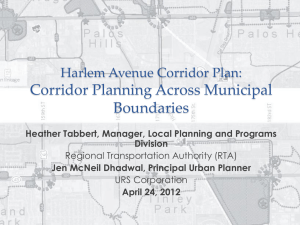Smart Corridor - Scott Crombie
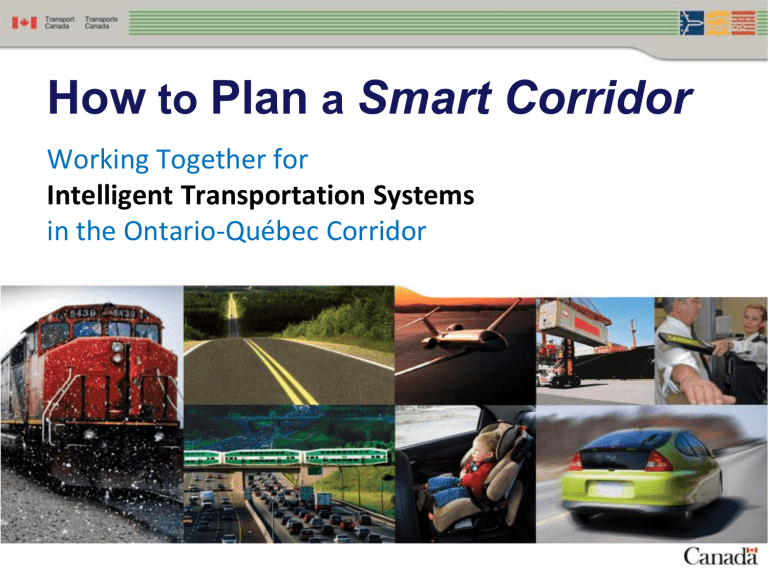
How
to
Plan
a
Smart Corridor
Working Together for
Intelligent Transportation Systems in the Ontario-Québec Corridor
OUTLINE
Intelligent Transportation Systems (ITS)
What is ITS?
What is the Value of ITS ?
What is a Smart Corridor ?
How do you Achieve Integration ?
The OntarioQuébec Smart Corridor
Where we are in the planning process
What we’ve done, where we’re going and what to expect next
Websites and Contact Information
I ntelligent T ransportation S ystems
ITS at a glance
Weigh
Scale
Ontario
CVO
Enforcement
Ontario
Enforcement
Officer
= Effective
Decisions
License
Reader
Vehicle
Processing
Database
= Effective
Transponder
Antenna
Roadway
Loop Detector
Toll System
Border Wait
Time
Bridge
Authority
Driver
= Effective
Decisions
= Effective
Decisions
I ntelligent T ransportation S ystems
ITS at a glance
Road Weather
Information Systems
(RWIS)
Automatic
Vehicle
Identification
(AVI)
Traffic
Signal Control
Variable Message Sign (VMS)
Variable Lane Control
I ntelligent T ransportation S ystems
ITS at a glance
Intermodal Freight Management
Advanced Traveller Information Systems (ATIS)
What is the Value of ITS ?
ITS address the critical challenges!
- Efficiency, Safety, Security and Sustainability
Relative to Infrastructure… ITS is CHEAP
- ITS projects typically cost $100Ks to $1Ms
- Infrastructure projects can cost $100Ms
Benefit/Cost Ratios of ITS projects are HIGH
- Stand-alone ITS projects sit at about 9:1
- Integrated ITS projects jump to 23:1
BOTTOM LINE:
Planning ITS projects so that they can be integrated is clearly critical!!
What is a SMART CORRIDOR ?
What makes a corridor “ SMART ”?
• Integrating existing and new ITS to improve operational efficiency
• Sharing information among systems to achieve benefits of coordinated operations
Opportunities
• Electronic filing of credentials/reporting
• Automated means of inspection
• Automated authentication of vehicles, cargo, and personnel
• Seamless electronic transactions/payments
• Readily accessible travel conditions information
Integration Smart Corridor
How Do You Achieve
INTEGRATION ?
To build a SMART CORRIDOR we need INTEGRATION
To achieve INTEGRATION we need COOPERATION
COOPERATION
• between organizations and agencies
• across borders
• from one jurisdiction to the next
How Do You Achieve
INTEGRATION ?
We also need strong PLANNING
Strong ITS Plan Smart Corridor
We have ITS PLANNING TOOLS
These TOOLS are built from basic COMPONENTS :
- The types of PLAYERS needed to deliver a service
- Vendor, Shipper, Consignee, Border Agency, Customs Agency
- The PHYSICAL components of the system
- Commercial Vehicle, Border Inspection Station, Administration Centres
- The INFORMATION exchanges between players
- Shipping Manifests, Driver Credentials, Safety Status, Routing, Customs
Payment Information, Inspection Reports
How Do You Achieve
INTEGRATION ?
For example, we can identify the TYPES of PLAYERS …
Shipper
Commercial Vehicle
Enforcement
Agency
Driver
[Automated Commercial Vehicle Inspection Station By-Pass]
How Do You Achieve
INTEGRATION ?
We can identify some of the PHYSICAL components…
Shipper
Commercial Vehicle
Enforcement
Agency
Driver
Safety/Credentials
Database
Commercial
Vehicle
Weigh-In-Motion
Inspection Station
[Automated Commercial Vehicle Inspection Station By-Pass]
How Do You Achieve
INTEGRATION ?
And we can identify INFORMATION FLOWS …
Credentials
Driver Record
Safety Status
Shipper
Driver
Citation
Commercial Vehicle
Enforcement
Agency
Credentials
Driver Record
Safety Status
By-Pass Signal
Safety/Credentials
Database
Commercial
Vehicle
Vehicle ID
Weight & Presence
Weigh-In-Motion
Inspection Station
[Automated Commercial Vehicle Inspection Station By-Pass]
How Do You Achieve
INTEGRATION ?
Finally, when we take a step back… we can see how all the PLAYERS interact!
INTEGRATED PLAN
!
How Do You Achieve
INTEGRATION ?
This INTEGRATED PLAN is called:
The NATIONAL ITS ARCHITECTURE
It can be applied to a specific REGION to create:
A REGIONAL ITS ARCHITECTURE
Using these TOOLS we can build a CONCEPT OF OPERATIONS .
How Do You Achieve
INTEGRATION ?
What’s the Process?
(For developing a Regional ITS Architecture)
1. Define the Region
2. Identify Stakeholders
3. Inventory Systems
4. Determine Needs and Services
5. Interconnects
6. Information Flows
7. Operational Concept
8. Standards
9. Define Project Sequencing
10. Identify Inter-Agency Agreements
Gather Critical Information
This is where the
National ITS Architecture helps out!!
The OntarioQuébec
Smart Corridor
Where are we?
1. Define the Region
2. Identify Stakeholders
3. Inventory Systems
Somewhere in and about here!!
4. Determine Needs and Services
5. Interconnects
6. Information Flows
7. Operational Concept
8. Standards
9. Define Project Sequencing
10. Identify Inter-Agency Agreements
The OntarioQuébec
Smart Corridor
Some of the Basics…
Who?
• Transport Canada, Ontario Ministry of Transportation, Ministère des transports du Québec
• IBI Group, Roche Consulting, Cambridge Systematics, ConSysTec
• Many Stakeholders
What?
• Develop Concept of Operations and Regional ITS Architecture for the
OntarioQuébec Corridor
When?
• April 2011 March 2012
The OntarioQuébec
Smart Corridor
1. Define the Region
The OntarioQuébec
Smart Corridor
2. Identify Stakeholders
Multi-modal:
• Surface, Air, Rail, Marine
• Freight/Goods Movement Focus
• Includes Border Crossings !!
Includes all levels of Government:
• Transport Canada, CBSA, CBP, FHWA
• Ontario Ministry of Transportation, Ministère des transports du
Québec, State of Michigan Department of Transportation
• Numerous regions and municipalities throughout the corridor
Includes Private Sector:
• Industry Associations, Commercial Carriers
We will continue to add Stakeholder throughout the project
The OntarioQuébec
Smart Corridor
2. Identify Stakeholders
We have engaged Stakeholder through:
• Two series of workshops
1 st Round of Workshops:
• Focused on engaging Stakeholders
• Discussed vision and “Architecture” process
• Discussed needs and services
• Windsor, Toronto, Ottawa/Gatineau, Montréal, Sherbrooke, Québec
2 nd Round of Workshops:
• Reviewed the vision for the “Smart Corridor”
• Feedback on Stakeholder descriptions
• Feedback on preliminary ITS Systems inventory
• Reviewed operational scenarios and information flows
• Windsor, Toronto, Ottawa/Gatineau, Montréal, Québec
The OntarioQuébec
Smart Corridor
3. Inventory Systems
An inventory of the ITS Systems in the corridor:
• Collected by Stakeholder Survey
• Verified at 2 nd Stakeholder Workshops
• Continues to be updated…
4. Determine Needs and Services
Needs and Services were discussed with Stakeholders:
• Discussed through “Breakout” sessions at Workshops
• SWOT Analysis (Strengths, Weaknesses, Opportunities, Threats)
• Continues to be updated…
The OntarioQuébec
Smart Corridor
4. Determine Needs and Services
Stakeholders identified the need to improve:
• The coordination and dissemination of real-time traveller information
• Traffic management including incident management and interjurisdictional coordination
• The efficiency of border customs inspections
• The efficiency of international crossings and other tolled facilities
• The efficiency of intermodal transfer points
• The efficiency of roadside safety inspections
• Management of dangerous goods movements
• Commercial vehicle on-board systems
• Tracking of shipments
The OntarioQuébec
Smart Corridor
Next Steps
Concept of Operations
• All stakeholders to reach consensus on the Concept of Operations
• Develop a list of proposed projects and required inter-agency agreements
Continue to work with Stakeholders
• There are two “Webinar” sessions scheduled in the up-coming months to confer on the results
Share the Results
• This process is meant to guide stakeholder investment
The OntarioQuébec
Smart Corridor
Websites
• OntarioQuébec Smart Corridor http://onqcsmartcorridor-onqccorridorintelligent.ca
• National ITS Architecture for Canada http://www.tc.gc.ca/eng/innovation/its-architecture.htm
• Border Information Flow Architecture http://www.tc.gc.ca/eng/innovation/its-border_information_flow_architec-270.htm
Contact Information
Scott Crombie
Intelligent Transportation Systems
Transport Canada
(613) 949-4902
